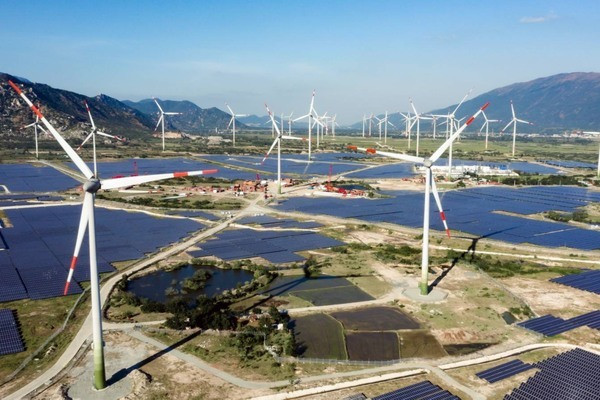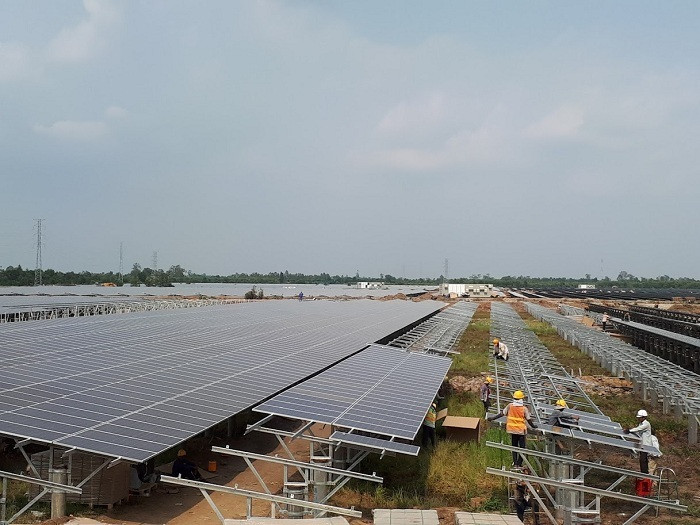
Vietnam is known as a factory of the world. But with commitments made at the 2021 United Nations Climate Change Conference, more commonly referred to as COP26, Vietnam must become a "green factory", a green production center of the world.
On February 14, at a meeting with Mr. Alok Kumar Sharma, Minister, President of COP26, Vietnamese Minister of Natural Resources and Environment Tran Hong Ha said that Vietnam's draft electricity master plan will gradually switch to clean energy sources.
This is also one of the contents to concretize Vietnam's commitment at COP26: To bring emissions to zero by 2050, in order to keep the global temperature rise at the threshold of 1.5 degrees Celsius by the end of the century, while gradually phasing out fossil energy, developing clean energy, and reducing methane emissions.
On January 30, the Government Office announced the conclusion of Prime Minister Pham Minh Chinh at the first meeting of the National Steering Committee on the Implementation of Vietnam's Commitments at COP26.
The Prime Minister said: "It is necessary to combine harmoniously, rationally and effectively green transformation with digital transformation and other key political tasks; mobilize the synergy of the whole political system, domestic and foreign resources, state and private resources, and convey the spirit of green transformation to ministries, agencies, localities and people.”
To do so, Vietnam will have to change from the way energy is used in production, to the creation of products.
Vice President of the Vietnam Association for Environmental Economics (VIASEE), Director of the Institute of Environmental Economic Policy, Dr. Nguyen The Chinh said that Prime Minister Pham Minh Chinh's commitments at COP26 will be a turning point for restructuring the economy towards "low-carbon" emissions, "green economy" and moving from linear economy to "circular economy". These commitments also contribute to the implementation of the Party's greater policy, which is rapid and sustainable development.
“To achieve the Net Zero commitment by 2050, it will require a combination of renewable energy development and fossil fuel removal, increased storage flows to balance the grid, removal of carbon from the atmosphere, increased flexibility in electricity demand, strengthened grid development, flexible electricity price mechanism and many other policies and actions,” said Mr. Mark Hutchinson, from the Global Wind Energy Council.
In fact, many large foreign corporations that have factories in Vietnam are gradually shifting to the use of cleaner energy sources. That is why the Direct Power Purchase Agreement (DPPA) mechanism is being developed by the Ministry of Industry and Trade with the support of the United States Agency for International Development (USAID).
The Ministry of Planning and Investment is developing the National Action Plan on Green Growth in the 2021-2030 period, with a vision to 2050 to submit to the Government for approval.
This plan concretizes the Green Growth Strategy and serves as a premise for the roadmap on net zero emission process, together with strategies, master plans, etc., to form an overall system of policies for green and sustainable socio-economic development. The strategy also sets out orientations for building and implementing the circular economy model in industrial parks, ecological industrial clusters, and sustainable craft villages.
The circular economy

The "circular economy" model has become more popular. The Decree guiding the implementation of the Law on Environmental Protection, issued on January 10, also mentions the circular economy for the first time.
According to the European Chamber of Commerce (Eurocham), the circular economy is a new reference model of production and consumption, including sharing, leasing, redesigning, collecting, reusing, repairing, refurbishing and recycling existing materials and products as often as possible. This is a more sustainable growth model than the previously dominant linear economy of produce-use-discard.
The new model deals with reducing waste to a minimum and using waste materials more efficiently in another form, reducing the need for raw materials, and removing most of the waste and pollution from the production method.
According to the Ministry of Planning and Investment, green growth opens up opportunities for the development of new green industries, which are those that provide traditional environmental goods and services (environmental consulting, pollution control, waste management/recycling), low-carbon goods and services (energy-saving products, green technology and equipment, carbon market).
According to this agency, green growth in industry also contributes to upgrading and completing the value chain, shifting from the mining, manufacturing, processing, assembly industries with low added value to the technology-intensive, deep processing industry associated with support industries; improving the rate of localization, added value and closing the value chain; strengthening the self-reliance and resilience of industries to raw material shocks (source and price), supply chain disruptions.
Many countries and regions are also moving strongly to green manufacturing. According to the report of the United Nations Environment Program, the green approach to economic recovery or “green recovery” - towards the dual goals of economic growth and environmental protection, response to change climate - is the first choice being encouraged by the United Nations.
The EU has implemented the European Green Agreement for the period 2020-2024 with a comprehensive renewal package “Fit for 55” to transform the entire bloc into a just, prosperous society, modern, competitive, resource efficient economy, becoming the first continent in the world to achieve carbon neutrality by 2050 and spend 37% of the Resilience Fund - or about 672.5 billion euros - for green projects.
South Korea also carries out the Green New Economic Agreement focusing on three areas: developing high-tech industries and digital transformation along with green economic development, and ensuring social security.
Eurocham recommended that Vietnam build a reasonable base to be able to apply the "circular economy" growth model in the future, a model that has been applied in the EU in the past few years. Moving further towards a circular economy will help reduce pressure on the environment, improve supply security and raw material prices, increase competitiveness, stimulate innovation, promote economic growth, and create green and sustainable jobs.
However, to become a green production center with net zero emissions, the challenge for a developing country like Vietnam is formidable.
According to the Ministry of Planning and Investment, the first difficulty is that the technology for carbon reduction and recycling already exists, but the technology for carbon reuse and removal is still in shortage. Current carbon capture and storage technologies are energy-intensive and water-intensive. Research and commercialization of this technology requires funding for research and development, financial subsidies to offset the risks of unproven technologies, tax incentives, and investment subsidies by direct capital.
“The green transition and the development of clean energy must be carried out not only at a business or a production stage, but throughout the supply chain. This is especially evident in some manufacturing industries such as steel and cement production, information and communication industries. This challenge is also clearly seen in the construction industry,” said the Ministry of Planning and Investment.
To move up a higher ladder, the creation of green products is an irreversible consumption trend. Europe has initiated a number of new trade mechanisms such as the “Carbon Border Adjustment Mechanism” (CBAM) to tax potentially polluting imports such as steel, aluminum and fertilizers.
This may be a new trend in the future and will be included in the negotiation programs and trade agreements. Countries like Vietnam, if not making timely transformation, will be at a disadvantage when exporting goods to this market.
If Vietnam upholds social and environmental responsibility to jointly solve global problems such as climate change and reduce greenhouse gas emissions, it will open up many development opportunities, and promote investment and trade in green products and services.
Luong Bang – Kien Trung